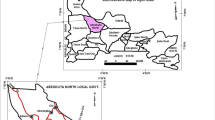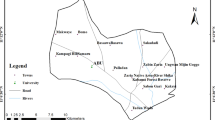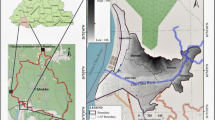Abstract
Groundwater is the most important natural resource around the world which needs new and advanced technologies for control and monitoring. This investigation was to check the groundwater potential zones by integrated techniques of geoinformatics and geophysical investigation through a vertical electrical sounding in Rawalakot, Azad Kashmir, Pakistan. The study area being a sedimentary basin, sandstone is the major rock type with good porosity and permeability. Satellite data were used to generate different thematic maps such as slope percent, lineament density, land use/cover, drainage density, geology, roughness index, curvature, topographic wetness index, and rainfall. Subsequently suitable rank and weightage was assinged for final weight overlay analysis to identify the groundwater potential zones. Final potential map was generated with good, moderate, and poor zones. This analysis revealed that 92.60% of the area is categorized to be having good to moderate groundwater potential. Then, an electrical resistivity survey was done by vertical electrical sounding (VES) using Schlumberger electrode configuration, at 32 locations to check the subsurface condition. The predominant curve types were Q type, A type, H type, and K type. The apparent resistivity was calculated at 20-m, 40-m, and 60-m depths. Dar-Zarrouk parameters were calculated to identify the subsurface aquifers and protective capacity rating. Integrating the outcome of GIS and geophysical studies, the region with good groundwater potential was delineated with more accuracy.














Similar content being viewed by others
Explore related subjects
Discover the latest articles and news from researchers in related subjects, suggested using machine learning.References
Abdullah T, Ali S, Al-Ansari N, Knutsson S (2015) Groundwater vulnerability mapping using lineament density on standard DRASTIC model: case study in Halabja Saidsadiq Basin Kurdistan Region. Iraq Eng 7:644–667
Abdullahi B, Rai J, Momoh M, Udensi E (2013) Effect of lineaments on groundwater occurrence. Int J Environ Bioenergy 8:22–32
Adagunodo T (2017) Groundwater pollution and control: an overview
Adagunodo T, Sunmonu L (2013) The study of basement pattern of an industrial estate. LAMBERR Academic Publishing,
Adagunodo TA, Adetunji A, Erinle A, Akinwumi S, Adewoyin O, Joel E, Kayode O (2017) Geophysical investigation into the integrity of a reclaimed open dumpsite for civil engineering purpose. Interciencia J 42:324–339
Adeoti L, Alile O, Uchegbulam O, Adegbola R (2012) Geoelectrical investigation of the groundwater potential in Mowe, Ogun State, Nigeria. Br J Appl Sci Technol 2:58–71
Adiat K, Nawawi M, Abdullah K (2012) Assessing the accuracy of GIS-based elementary multi criteria decision analysis as a spatial prediction tool–a case of predicting potential zones of sustainable groundwater resources. J Hydrol 440:75–89
Ahmed W, Anwar S, Abbas SA, Khan S, Ahmed KA (2018) Geo-electrical survey for the appraisal of groundwater resource in Siwalik group: a case study of Khrick Rawalakot, Azad Kashmir. J Himal Earth Sci 51
Akhter G, Hasan M (2016) Determination of aquifer parameters using geoelectrical sounding and pumping test data in Khanewal District. Pakistan Open Geosci 8:630–638
Akinwumiju A, Olorunfemi M, Afolabi O (2016) Automated lineament mapping from remotely sensed data: case study Osun drainage basin, southwestern Nigeria Ife. J Sci 18:177–201
Al Saud M (2010) Mapping potential areas for groundwater storage in Wadi Aurnah Basin, western Arabian Peninsula, using remote sensing and geographic information system techniques. Hydrogeol J 18:1481–1495
Anbazhagan SP, Paramasivam CR (2016) Assessment of Land use and Land cover changes in Magnesite Mining Region, Salem, India. Int J Earth Sci Eng (IJEE), Cafet Innova 9:898–903
Anomohanran O (2013) Geoelectrical investigation of groundwater condition in Oleh, Nigeria. Int J Res Rev Appl Sci 15:145–151
Anudu G, Onuba L, Ufondu L (2011) Geoelectric sounding for groundwater exploration in the crystalline basement terrain around Onipe and adjoining areas, southwestern Nigeria. J Appl Technol Environ Sanitation 1:343–354
Ashraf M, Chaudhry MN (1980) The volcanic rocks of Poonch District. Azad Kashmir Proc Intern Sommit Geodynamics, Group 6:23–29
Atekwana EA, Sauck WA, Werkema DD Jr (2000) Investigations of geoelectrical signatures at a hydrocarbon contaminated site. J Appl Geophys 44:167–180
Batayneh AT (2013) The estimation and significance of Dar-Zarrouk parameters in the exploration of quality affecting the Gulf of Aqaba coastal aquifer systems. J Coast Conserv 17:623–635
Das D (2000) GIS application in hydrogeological studies Available from: http://www gisdevelopment net/application/nrm/water/overview/wato0003 htm (accessed March 2010)
Das S, Behera S, Kar A, Narendra P, Guha S (1997) Hydrogeomorphological mapping in ground water exploration using remotely sensed data—a case study in Keonjhar district, Odisha. J Ind Soc Remote Sens 25:247–259
Devaraj N, Chidambaram S, Panda B, Thivya C, Thilagavathi R, Ganesh N (2018) Geo-electrical approach to determine the lithological contact and groundwater quality along the KT boundary of Tamilnadu. India Model Earth Syst Environ 4:269–279
Ekwe A, Onu N, Onuoha K (2006) Estimation of aquifer hydraulic characteristics from electrical sounding data: the case of middle Imo River basin aquifers, south-eastern Nigeria. J Spatial Hydrol 6
Ettazarini S (2007) Groundwater potentiality index: a strategically conceived tool for water research in fractured aquifers. Environ Geol 52:477–487
Hasan M, Shang Y, Akhter G, Jin W (2018) Delineation of Saline-Water Intrusion Using Surface Geoelectrical Method in Jahanian Area, Pakistan. Water 10:1548
Hasan M, Shang Y, Akhter G, Khan M (2017) Geophysical investigation of fresh-saline water interface: A case study from South Punjab. Pakistan Groundwater 55:841–856
Hubbard SS, Rubin Y (2005) Introduction to hydrogeophysics. In: Hydrogeophysics. Springer, pp 3-21
Hung L, Batelaan O, De Smedt F (2005) Lineament extraction and analysis, comparison of LANDSAT ETM and ASTER imagery. Case study: Suoimuoi tropical karst catchment, Vietnam. In: Remote sensing for environmental monitoring, GIS applications, and geology V. International Society for Optics and Photonics, p 59830 T
Ijaz U, Yasin M (2017) Determination of Ground water potential by electric resistivity method in Rawalakot and adjoining areas of the Sub-Himalayan fold and thrust Belt of Pakistan. Pakistan Journal of Geology (PJG) 1:1–4
Joel E, Olasehinde P, De DK, Omeje M, Adewoyin O (2016) Estimation of aquifer transmissivity from geo-physical data. A case study of Covenant University and Environs, southwestern Nigeria. Sci Int(Lahore) 28:3379–3385
Keller GV, Frischknecht FC (1966) Electrical methods in geophysical prospecting
Leduc C, Favreau G, Schroeter P (2001) Long-term rise in a Sahelian water-table: The Continental Terminal in south-west Niger. J Hydrol 243:43–54
Loke M (2000) Electrical imaging surveys for environmental and engineering studies: A practical guide to 2-D and 3-D surveys Electronic version available from http://www terra plus com
Loke M (2004) Tutorial: 2-D and 3-D electrical imaging surveys.
Meju MA (2000) Geoelectrical investigation of old/abandoned, covered landfill sites in urban areas: model development with a genetic diagnosis approach. J Appl Geophys 44:115–150
Metwaly M, El-Qady G, Massoud U, El-Kenawy A, Matsushima J, Al-Arifi N (2010) Integrated geoelectrical survey for groundwater and shallow subsurface evaluation: case study at Siliyin spring, El-Fayoum. Egypt Int J Earth Sci 99:1427–1436
Mokarram M, Roshan G, Negahban S (2015) Landform classification using topography position index (case study: salt dome of Korsia-Darab plain, Iran). Model Earth Syst Environ 1:40
Mondal MS, Pandey A, Garg R (2008) Groundwater prospects evaluation based on hydrogeomorphological mapping using high resolution satellite images: a case study in Uttarakhand. J Ind Soc Remote Sens 36:69
Nadeem F (2015) Pakistan Monsoon 2015 Rainfall. CDPC Technical Report, 4
Nair HC, Padmalal D, Joseph A, Vinod P (2017) Delineation of groundwater potential zones in river basins using geospatial tools—an example from southern western Ghats Kerala, India. J Geovis Spat Anal 1:5
Ndlovu S, Mpofu V, Manatsa D, Muchuweni E (2010) Mapping groundwater aquifers using dowsing, slingram electromagnetic survey method and vertical electrical sounding jointly in the granite rock formation: a case of Matshetshe rural area in Zimbabwe
Niaz A, Khan MR, Ijaz U, Yasin M, Hameed F (2018) Determination of groundwater potential by using geoelectrical method and petrographic analysis in Rawalakot and adjacent areas of Azad Kashmir, sub-Himalayas, Pakistan Arabian. J Geosci 11:468
Niwas S, Gupta PK, de Lima OA (2006) Nonlinear electrical response of saturated shaley sand reservoir and its asymptotic approximations. Geophysics 71:G129–G133
Oladapo M, Akintorinwa O (2007) Hydrogeophysical study of Ogbese South Western Nigeria Global. J Pure Appl Sci 13:55–61
Oyeyemi KD, Aizebeokhai A, Adagunodo T, Olofinnade O, Sanuade O, Olaojo A (2017) Subsoil characterization using geoelectrical and geotechnical investigations: implications for foundation studies. Int J Civil Eng Technol 8:302–314
Paramasivam C (2019) Merits and Demerits of GIS and Geostatistical Techniques GIS and Geostatistical Techniques for Groundwater Science Book 17-21
Paramasivam C, Venkatramanan S (2019) An Introduction to Various Spatial Analysis Techniques GIS Geostat Tech Groundwater Sci 23-30
Riley SJ, DeGloria SD, Elliot R (1999) Index that quantifies topographic heterogeneity intermountain. J Sci 5:23–27
Sabins FF (1987) Remote Sensing Principles and Interpretation WH Freeman and Company 7:251-253
Sankar K, Jegatheesan M, Balasubramanian A (1996) Geoelectrical resistivity studies in the Kanyakumari District Tamil Nadu. J Appl Hydrol 9:83–90
Seeber L, Armbruster JG, Quittmeyer RC (1981) Seismicity and continental subduction in the Himalayan arc Zagros Hindu Kush Himalaya Geodynamic Evolution 215-242
Selvam S, Dar FA, Magesh N, Singaraja C, Venkatramanan S, Chung S (2016) Application of remote sensing and GIS for delineating groundwater recharge potential zones of Kovilpatti Municipality, Tamil Nadu using IF technique. Earth Sci Inf 9:137–150
Shah I (1977) Stratigraphy of Pakistan. Mem Geol Surv Pak 12:138
Shah S (2009) Stratigraphy of Pakistan (Memoirs of the Geological Survey of Pakistan) Published by Geological Survey of Pakistan 22
Shahid S, Nath S, Patra H (2000) Ground water assessment and management within typical laterites around Salboni, District Medinipur (WB). J-Ind WaterWorks Assoc 32:101–106
Srivastava V, Giri DN, Bharadwaj P (2012) Study and mapping of ground water prospect using remote sensing, GIS and geoelectrical resistivity techniques—a case study of Dhanbad district, Jharkhand. India J Ind Geophys Union 16:55–63
Strahler AN (1957) Quantitative analysis of watershed geomorphology Eos. Trans Am Geophys Union 38:913–920
Suneetha N, Gupta G (2018) Evaluation of groundwater potential and saline water intrusion using secondary geophysical parameters: A case study from western Maharashtra, India. In: E3S Web of Conferences. EDP Sciences, 54, p 00033
ur Rashid M, Anwar S, Abbas SA, Ahmad W (2019) Geoelectrical survey for the exploration of ground water using vertical electrical sounding: a case study of Androt District Rawlakot, Azad Jammu & Kashmir. Int J Econ Environ Geol 26–31
Venkatramanan S, Viswanathan PM, Chung SY (2019) GIS and Geostatistical Techniques for Groundwater Science. Elsevier,
Verma A, Singh T (2013) Prediction of water quality from simple field parameters. Environ Earth Sci 69:821–829
Vrba J, Verhagen BT (2006) Groundwater for emergency situations: a framework document. United Nations Educational, Scientific and Cultural Organization (UNESCO),
Wadia DN (1928) The geology of Poonch State (Kashmir) and adjacent portions of the Punjab. Mem Geol Surv India 51:185–370
Yang C-S, Kao S-P, Lee F-B, Hung P-S (2004) Twelve different interpolation methods: A case study of Surfer 8.0. In: Proceedings of the XXth ISPRS Congress. pp 778-785
Yeh H-F, Cheng Y-S, Lin H-I, Lee C-H (2016) Mapping groundwater recharge potential zone using a GIS approach in Hualian River, Taiwan. Sustain Environ Res 26:33–43
Zeinelabdein KAE, Elsheikh AE, Bireir FA (2014) Hydro-geophysical study in Al-Khogalab basement-sedimentary basin transition area using Vertical Electrical Sounding method. Khartoum State, Central Sudan
Acknowledgments
The authors thank the Resources Information Development and Research Key Laboratory of Beijing and their supervisor for the opportunity and encouragement during the research work. Umair Rasool is especially thankful to Dr. Mureed Hussain Khosa, head of the Department of Marine Geology, Lasbela University of Agriculture, Water and Marine Sciences, Baluchistan, Pakistan, for his help during the field work and interpretation of resistivity data.
Author information
Authors and Affiliations
Corresponding author
Additional information
This article is part of the Topical Collection on Recent advanced techniques in water resources management
Rights and permissions
About this article
Cite this article
Rasool, U., Chen, J., Muhammad, S. et al. Geoinformatics and geophysical survey-based estimation of best groundwater potential sites through surface and subsurface indicators. Arab J Geosci 13, 702 (2020). https://doi.org/10.1007/s12517-020-05496-3
Received:
Accepted:
Published:
DOI: https://doi.org/10.1007/s12517-020-05496-3
Keywords
Profiles
- Muhammad Amir Siddique View author profile




